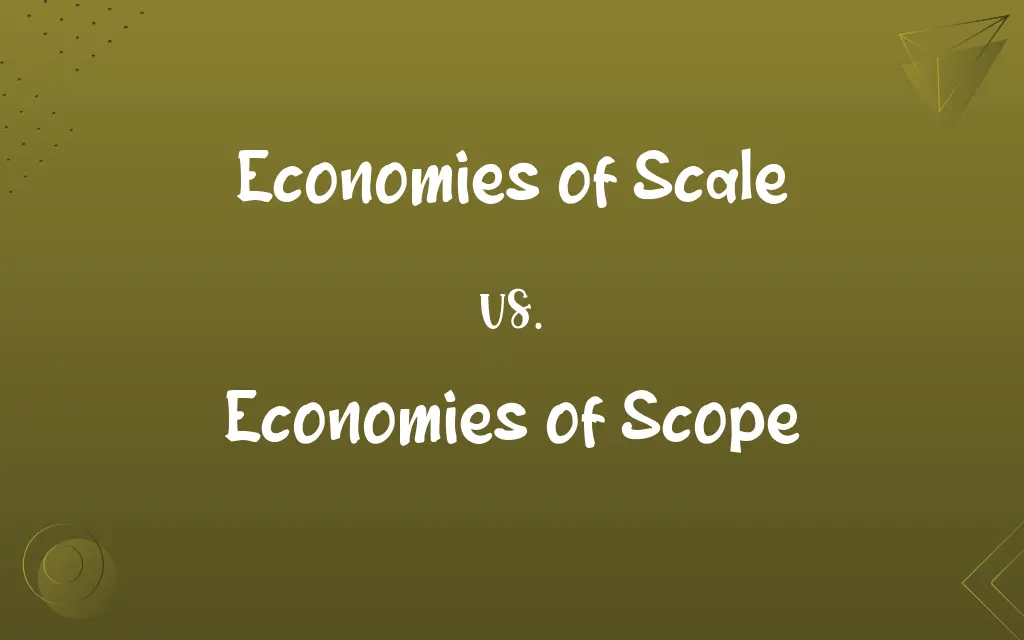Economies of Scale vs. Economies of Scope: Know the Difference

By Shumaila Saeed || Published on January 19, 2024
Economies of Scale refer to cost advantages due to increased output, while Economies of Scope relate to cost benefits from producing a variety of products.

Key Differences
Economies of Scale are achieved when increasing production leads to lower costs per unit. This occurs due to the spreading of fixed costs over more units, improving efficiency and technology over time. Economies of Scope, in contrast, arise when a company efficiently produces a wider range of products, leading to cost savings by sharing resources across different products.
Shumaila Saeed
Jan 19, 2024
The concept of Economies of Scale often applies to large-scale production where bulk buying of materials, better utilization of equipment, or spreading administrative costs over more units can reduce the average cost. Economies of Scope, however, take advantage when different goods or services share common operations, inputs, or marketing strategies, allowing for diversified product lines at lower overall costs.
Shumaila Saeed
Jan 19, 2024
Economies of Scale encourage specialization in a single product or a limited range, focusing on high volume for cost efficiency. This is common in industries like automobile manufacturing or steel production. Conversely, Economies of Scope are more about diversification, where a company might use its existing capabilities to produce different but related products, like a dairy company producing cheese, yogurt, and butter.
Shumaila Saeed
Jan 19, 2024
Achieving Economies of Scale often requires significant initial investment in machinery and infrastructure, which becomes more cost-effective as production volume increases. In contrast, Economies of Scope can benefit from existing infrastructure but require strategic planning to manage diverse product lines without compromising quality or efficiency.
Shumaila Saeed
Jan 19, 2024
Economies of Scale lead to a competitive advantage by lowering unit costs, potentially resulting in lower prices or higher margins. Economies of Scope, on the other hand, allow companies to offer a broader range of products, catering to varied customer needs and creating a competitive edge through product diversity.
Shumaila Saeed
Jan 19, 2024
ADVERTISEMENT
Comparison Chart
Focus
Reducing cost per unit by increasing production volume.
Reducing overall costs by producing a variety of products.
Shumaila Saeed
Jan 19, 2024
Cost Savings
Achieved through high volume production.
Achieved through shared use of resources.
Shumaila Saeed
Jan 19, 2024
Investment
High initial capital for mass production.
Strategic investment in versatile operations.
Shumaila Saeed
Jan 19, 2024
Competitive Advantage
Lower prices or higher profit margins.
Broad product offerings and market appeal.
Shumaila Saeed
Jan 19, 2024
ADVERTISEMENT
Economies of Scale and Economies of Scope Definitions
Economies of Scale
Achieving lower unit costs through large-scale production and operational efficiency.
By producing more widgets, the widget factory lowered its cost per widget.
Shumaila Saeed
Jan 07, 2024
Economies of Scope
Reduction in average cost achieved by increasing the variety of goods produced.
An electronics firm produces phones, laptops, and tablets, utilizing shared technology and expertise.
Shumaila Saeed
Jan 07, 2024
Economies of Scale
Cost advantages obtained due to the expansion of the scale of production in a single product line.
A steel plant reduces its cost per ton as it increases its total output.
Shumaila Saeed
Jan 07, 2024
Economies of Scope
Cost advantage from producing a variety of goods, exploiting commonalities in production.
A beverage company produces soft drinks, juices, and water, sharing bottling and distribution channels.
Shumaila Saeed
Jan 07, 2024
Economies of Scale
Lowering average costs through a greater volume of output.
A solar panel company decreased the cost of each panel as production scaled up.
Shumaila Saeed
Jan 07, 2024
ADVERTISEMENT
Economies of Scope
Economic efficiencies from diversifying product lines using shared resources.
A clothing manufacturer uses its fabric and design team to produce both formal and casual wear.
Shumaila Saeed
Jan 07, 2024
Economies of Scale
Reduction in cost per unit resulting from increased production, due to efficient resource utilization.
A car manufacturer reduces the cost of each vehicle as the number of cars produced increases.
Shumaila Saeed
Jan 07, 2024
Economies of Scope
Cost efficiencies realized by producing a range of products rather than focusing on a single output.
A farm produces both dairy and meat products, reducing overall costs.
Shumaila Saeed
Jan 07, 2024
Economies of Scale
Savings in costs gained by an increased level of production.
The bakery reduced the cost per loaf of bread by doubling its daily production.
Shumaila Saeed
Jan 07, 2024
Economies of Scope
Savings achieved from producing multiple products using the same operations or inputs.
A publishing company produces books, magazines, and newspapers, sharing resources and lowering costs.
Shumaila Saeed
Jan 07, 2024
Repeatedly Asked Queries
What is Economies of Scale?
Economies of Scale refer to the decreased cost per unit when production is scaled up.
Shumaila Saeed
Jan 19, 2024
How do companies achieve Economies of Scale?
By increasing production volume, which spreads fixed costs over more units.
Shumaila Saeed
Jan 19, 2024
Are Economies of Scale more relevant to large or small companies?
They are typically more relevant to large companies due to high production volumes.
Shumaila Saeed
Jan 19, 2024
Is there a limit to Economies of Scale?
Yes, beyond a certain point, the benefits can diminish or become negative.
Shumaila Saeed
Jan 19, 2024
Can Economies of Scale lead to market dominance?
Yes, as they can allow companies to offer lower prices due to lower costs.
Shumaila Saeed
Jan 19, 2024
How is Economies of Scope different from Economies of Scale?
It focuses on cost savings through product diversification rather than volume increase.
Shumaila Saeed
Jan 19, 2024
Can Economies of Scope lead to a competitive advantage?
Yes, by offering a wider range of products to meet different consumer needs.
Shumaila Saeed
Jan 19, 2024
What is Economies of Scope?
It refers to cost savings from producing a variety of products rather than specializing in one.
Shumaila Saeed
Jan 19, 2024
Can small businesses benefit from Economies of Scope?
Yes, especially if they can efficiently manage diverse product lines.
Shumaila Saeed
Jan 19, 2024
Is technology important in achieving Economies of Scale?
Yes, technology can significantly enhance production efficiency and lower costs.
Shumaila Saeed
Jan 19, 2024
Does customer demand influence Economies of Scale?
Yes, higher demand can justify the increase in production volume.
Shumaila Saeed
Jan 19, 2024
What role does supply chain management play in Economies of Scale?
Efficient supply chain management is crucial for reducing costs as production scales.
Shumaila Saeed
Jan 19, 2024
Are Economies of Scope dependent on industry type?
Yes, they are more applicable in industries where product diversification is feasible.
Shumaila Saeed
Jan 19, 2024
Are Economies of Scope suitable for niche markets?
They can be, if the range of products serves different segments within the niche.
Shumaila Saeed
Jan 19, 2024
What are the risks of pursuing Economies of Scale?
Overproduction and increased operational complexity are common risks.
Shumaila Saeed
Jan 19, 2024
Does product quality impact Economies of Scope?
Yes, maintaining quality across diverse products is essential for realizing cost benefits.
Shumaila Saeed
Jan 19, 2024
How does Economies of Scope encourage innovation?
By allowing companies to experiment with various product lines.
Shumaila Saeed
Jan 19, 2024
Can a company achieve both Economies of Scale and Scope?
Yes, some large diversified companies achieve both through strategic operations.
Shumaila Saeed
Jan 19, 2024
How does market size affect Economies of Scale?
A larger market size allows for greater production volume and potential for scale.
Shumaila Saeed
Jan 19, 2024
Can outsourcing help in achieving Economies of Scope?
Yes, outsourcing can provide flexibility and cost savings in producing diverse products.
Shumaila Saeed
Jan 19, 2024
Share this page
Link for your blog / website
HTML
Link to share via messenger
About Author
Written by
Shumaila SaeedShumaila Saeed, an expert content creator with 6 years of experience, specializes in distilling complex topics into easily digestible comparisons, shining a light on the nuances that both inform and educate readers with clarity and accuracy.








































































